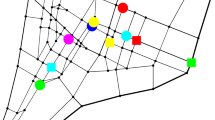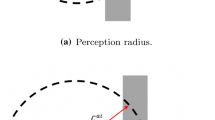Abstract
This paper presents a new algorithm for solving capacitated single depot vehicle routing problems without time windows in a fault-tolerant manner where the distances between points are symmetrical. The sudden breakdown of a vehicle on its pre-planned route is considered as a fault. In this case one of the other cooperating vehicles will take over the remaining tasks and perform them in the most effective way. We introduce the concept of “route change cost” as the difference between the length of the modified and the original routes of the helper vehicle, and our goal is to minimize this value. Starting from an arbitrary VRP solution, we determine the optimal direction, in terms of the route change cost, in which each route should be performed by a vehicle. A simulation with case studies was used to test the algorithm. We found that applying the proposed method, the execution of the original tasks requires routes with lengths 4.1–8.6% shorter on average than using the non-directed routes of the solution of the original vehicle routing problem in arbitrary directions.







Similar content being viewed by others
References
Al-Kanj L, Powell WB, Bouzaeine-Ayari B (2016) The information-collecting vehicle routing problem: stochastic optimization for emergency storm response. CoRR. ARxIV:1605.05711
Alba E, Dorronsoro B (2004) Solving the vehicle routing problem by using cellular genetic algorithms. In: Evolutionary computation in combinatorial optimization (EvoCOP). Lecture notes in computer science, vol 3004. Springer, Berlin, pp 11–20
Applegate DL, Bixby RE, Chvtal V, Cook WJ (2006) The traveling salesman problem: a computational study. Princeton University Press, Princeton
Berger J, Sassi M, Salois M (1999) A hybrid genetic algorithm for the vehicle routing problem with time windows and itinerary constraints. In: Proceedings of the genetic and evolutionary computation conference, Orlando. pp 44–51
Bianchi L, Birattari M, Chiarandini M, Manfrin M, Mastrolilli M, Paquete L, Rossi-Doria O, Schiavinotto T (2006) Hybrid metaheuristics for the vehicle routing problem with stochastic demands. J Math Model Algorithms 5(1):91–110
Bräysy O (2001) Genetic algorithms for the vehicle routing problem with time windows. Special issue on bioinformatics and genetic algorithms. Arpakannus 1:33–38
Cortés CE, Núñez AA, Sáez D (2008) Hybrid adaptive predictive control for a dynamic pickup and delivery problem including traffic congestion. Int J Adapt Control Signal Process 22(2):103–123
Crevier B, Cordeau JF, Laporte G (2007) The multi-depot vehicle routing problem with inter-depot routes. Eur J Oper Res 176:756–773
Dantzig GB, Fulkerson R, Johnson SM (1954) Solution of a large-scale traveling salesman problem. Oper Res 2(4):393–410
Dantzig GB, Ramser JH (1959) The truck dispatching problem. Manag Sci 6(1):80–91
dos Santos A, Barradas A, Labidi S, Costa N (2013) A comparison between optimization heuristics of the best path problem applied to S-route. In: Proceedings of GEOProcessing 2013—the fifth international conference on advanced geographic information systems, applications, and services, Athens. pp 172–177
Dror M, Trudeau P (1986) Stochastic vehicle routing with modified savings algorithm. Eur J Oper Res 23:228–235
Eksioglu B, Vural AV, Reisman A (2009) The vehicle routing problem: a taxonomic review. Comput Ind Eng 57(4):1472–1483
Gendreau M, Laporte G, Sguin R (1996) Stochastic vehicle routing. Eur J Oper Res 88:3–12
Goldberg DE (1989) Genetic algorithms in search optimization and machine learning. Addison Wesley, Reading
Goodson JC, Ohlmann JW, Thomas BW (2013) Rollout policies for dynamic solutions to the multi-vehicle routing problem with stochastic demand and duration limits. Oper Res 61(1):138–154
Ho W, Ho GTS, Ji P, Lau HCW (2008) A hybrid genetic algorithm for the multi-depot vehicle routing problem. Eng Appl Artif Intell 21(2008/4):548–557
Homberger J, Gehring H (1999) Two evolutionary metaheuristics for the vehicle routing problem with time windows. INFOR 37:297–318
Kilby P, Prosser P, Shaw P (1998) Dynamic VRPs: a study of scenarios. Technical report APES-06-1998. University of Strathclyde
Király A, Abonyi J (2010) A novel approach to solve multiple traveling salesmen problem by genetic algorithm. In: Kacprzyk J (ed) Studies in computational intelligence, vol 313. pp 141–151
Larsen A (2000) The dynamic vehicle routing problem. Ph.D. Dissertation, Technical University of Denmark
Mitchell T (1997) Machine learning (McGraw-Hill International Edit), 1st Edition. Chapter 9: genetic algorithms, McGraw-Hill Education (ISE Editions)
Nazif H, Lee LS (2010) Optimized crossover genetic algorithm for vehicle routing problem with time windows. Am J Appl Sci 7(2010/1):95–101
Noura H, Theillio D, Ponsart JC, Chamseddine A (2009) Fault-tolerant control systems: design and practical applications. Advances in industrial control. Springer, New York
Novaes AGN, Bez ET, Burin PJ (2013) Fault detection in dynamic vehicle routing operations. In: Kreowski H-J et al (eds) Dynamics in logistics. Lecture notes in logistics. Springer, Berlin, pp 13–32
Novoa C, Berger R, Linderoth J, Storer R (2006) A set-partitioning-based model for the stochastic vehicle routing problem. Technical report \(06T-008\), industrial and systems engineering. Lehigh University
Park YB (2001) A hybrid genetic algorithm for the vehicle scheduling problem with due times and time deadlines. Int J Prod Econ 73(2):175–188
Pillac V, Gendreau M, Guéret C, Medaglia AL (2013) A review of dynamic vehicle routing problems. Eur J Oper Res 225(1):1–11
Potvin J-Y, Bengio S (1996) The vehicle routing problem with time windows part II: genetic search. INFORMS J Comput 8:165–172
Renaud J, Laporte G, Boctor FF (1996) A tabu search heuristic for the multi-depot vehicle routing problem. Comput Oper Res 23:229–235
Ronald S, Kirkby S (1998) Compound optimization solving transport and routing problems with a multi-chromosome genetic algorithm. In: The 1998 IEEE international conference on evolutionary computation, ICEC’98. pp 365–370
Rybičková A, Karásková A, Mocková D (2015) Use of genetic algorithms for spare parts distribution system. In: Araujo A (ed) Engineering optimization 2014. CRC Press 2014, pp 639–644
Sahli S, Petch RJ (2007) A GA based heuristic for the vehicle routing problem with multiple trips. J Math Model Algorithms 6(4):591–613
Secomandi N (1998) Exact and heuristic dynamic programming algorithms for the vehicle routing problem with stochastic demands. Ph.D. Dissertation, University of Houston
Secomandi N, Margot F (2009) Reoptimization approaches for the vehicle routing problem with stochastic demands. Oper Res 57(1):214–230
Shen Z, Ordonez F, Dessouky MM (2009) The stochastic vehicle routing problem for minimum unmet demand. Optim Logist Chall Enterpr 30:349–371
Solomon MM (1987) Algorithms for the vehicle routing and scheduling problems with time window constraints. Oper Res 35:254–265
Sprenger R, Lars M (2014) A decision support system for cooperative transportation planning: design, implementation, and performance assessment. Expert Syst Appl 41(11):5125–5138
Stewart WR Jr, Golden BL (1983) Stochastic vehicle routing: a comprehensive approach. Eur J Oper Res 14(4):371–385
Suresh NK, Ramasamy P (2012) A survey on the vehicle routing problem and its variants. Intell Inf Manag 4(3):66–74
Tan KC, Lee LH, Ou K (2001) Artificial intelligence heuristics in solving vehicle routing problems with time window constraints. Eng Appl Artif Intell 14:825–837
Tang J, Pan Z, Fung RYK, Lau H (2009) Vehicle routing problem with fuzzy time windows. Fuzzy Sets Syst 160:683–695
Tansini L, Urquhart M, Viera O (2000) Comparing assignment algorithms for the multi-depot VRP. In: Latin-American conference on operations research and systems, Mexico City
Thangiah SR (1995) Vehicle routing with time windows using genetic algorithms. In: Chambers L (ed) Practical handbook of genetic algorithms: new frontiers, vol 11. pp 253–277
Wu TH, Low C, Bai JW (2002) Heuristic solutions to multi-depot location-routing problem. Comput Oper Res 29:1393–1415
Zhenggang D, Linning C, Li Z (2009) Improved multi-agent system for the vehicle routing problem with time windows. Tsinghua Sci Technol 14(3):407–412
Acknowledgements
The authors wish to thank Zoltán Juhász from University of Pannonia, Veszprém, Hungary, for his advice during the creation of this paper. The constructive and valuable suggestions and comments of the reviewers greatly improved the quality of this paper, and the authors wish to acknowledge that. This publication has been supported by the National Research, Development and Innovation Office under the Project Number K115694. This publication has been supported by the Hungarian Government through the Project VKSZ_14-1-2015-0190—Development of model based decision support system for cost and energy management of electronic assembly processes. We acknowledge the financial support of the Hungarian State and the European Union under the TAMOP-4.2.2.A-11/1/KONV-2012-0072.
Author information
Authors and Affiliations
Corresponding author
Appendices
Appendix 1: Clarke and Wright savings method
The Clarke and Wright savings method is an efficient, popular and widespread method for creating the routes of a VRP problem. The proposed algorithm of this paper can be applied for an arbitrary VRP solution (see Sect. 3.3). We chose the Clarke and Wright savings method for initial VRP solution creation because of its simplicity and wide usage in the VRP literature. Its main steps are as follows.
- Step 1::
-
Calculate the saving value \(S(m_{i}, m_{j}) = L(d, m_{i}) + L(d, m_{j}) - L(m_{i}, m_{j})\) for every pair \((m_{i}, m_{j})\) of customers.
- Step 2::
-
Order the saving values in descending order. This results in the “savings list”. Start the processing of the saving list with its first element.
- Step 3::
-
For the saving value \(S(m_{i}, m_{j})\) under consideration, include link \((m_{i}, m_{j})\) in a route if no route constraints will be violated, and if:
-
Either, neither \(m_{i}\) nor \(m_{j}\) have already been assigned to a route. In this case a new route is created including both \(m_{i}\) and \(m_{j}\).
-
Or, exactly one of the two customers (\(m_{i}\) or \(m_{j}\)) has already been included in an existing route and that customer is not interior to that route—the concept “interior to a route” means that the customer is not adjacent to the depot—, in which case the link \((m_{i}, m_{j})\) is added to that same route.
-
Or, both \(m_{i}\) and \(m_{j}\) have already been included in two different existing routes and neither customer is interior to its route. In this case the two routes are merged.
-
- Step 4::
-
If the end of the saving list has not been reached, process its next entry returning to Step 3; otherwise, stop. If there is any customer that has not been assigned to a route, it must be assigned to its own route, which begins at the depot, visits the customer (only one) and returns to the depot.
Appendix 2: The proposed algorithm
The flowchart of our algorithm is illustrated in Fig. 8.
Rights and permissions
About this article
Cite this article
Dulai, T., Werner-Stark, Á. & Hangos, K.M. Algorithm for directing cooperative vehicles of a vehicle routing problem for improving fault-tolerance. Optim Eng 19, 239–270 (2018). https://doi.org/10.1007/s11081-017-9353-6
Received:
Revised:
Accepted:
Published:
Issue Date:
DOI: https://doi.org/10.1007/s11081-017-9353-6





